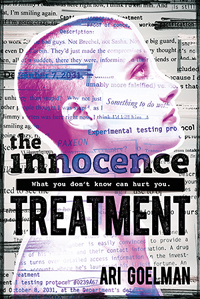| ________________
CM . . .
. Volume XXIV Number 3. . . .September 22, 2017

 |
The Innocence Treatment.
Ari Goelman.
New York, NY: Roaring Brook Press (Distributed in Canada by Raincoast Books), October, 2017.
264 pp., hardcover, $24.99.
ISBN 978-1-62672-880-6.
Grades 9-12 / Ages 14-18.
Review by Cate Carlyle.
*** /4
Reviewed from Advance Reading Copy.
|
| |
|

excerpt:
Case Notes of Dr. Finlay Brechel
December 2, 2031
The subject, Lauren Fielding, is a sixteen-year-old girl. Skinny, verging on gaunt, but muscular. Postoperative scars still visible through crew-cut hair. A far cry from her preoperative photos three months ago, where she was a slightly plump redhead with shoulder-length hair, smiling broadly in every picture.
According to her medical chart, she remanded herself to the custody of this facility twenty-three days ago, about two months after being treated here for a pre-existing disability. Neither the details of the initial disability, nor the course of treatment, are entirely clear to me, but as far as I can tell her disability had both cognitive and behavioral components. (Her medical papers repeatedly mention ďmodified oligodendrocytesĒ- I have no real idea what that means. I know oligodendrocytes area type of brain cell that connect different parts of the brain, but I canít imagine that itís possible to deliberately modify such tiny, poorly understood cells. (Ah, to be a neuroscientist instead of a humble psychologist...)
I have sent Dr. Corbin a note asking for more details regarding Ms. Fieldingís treatment and case history, but Iím not entirely sure Iíll understand any additional details she provides. It seems to me that Corbin is operating somewhere on the frontiers of brain science with her treatment of Ms. Fielding, while my understanding is stuck in 2024 or so.
What I do know is that Ms. Fielding is currently exhibiting pronounced signs of paranoid delusions. I believe these delusions are responsible for the multiple violent episodes sheís initiated since coming to this facility. Due to previous assaults on past therapists and orderlies (including a particularly violent one on the orderly Eric Schafer, who she mentions so favorably in her first journal entry), she is heavily restrained when we meet.
It is 2031, and Lauren Fielding is a 16-year-old student, the famous ďInnocence Girl ď, who believes whatever she is told and who requires a list of family rules to govern her actions and movements in order to keep her safe. Lauren does not understand sarcasm or nuance and believes everyone has her best interest at heart. When the opportunity arises for a surgery to correct her disorder, she jumps at the chance. Unfortunately, post-surgery Lauren presents as paranoid and violent. Her sister Evelyn tries to keep Lauren safe from the ďDepartmentĒ, the governing agency with an Orwellian hold on society, as does her new friend Sasha, an undercover double agent for the Department. Laurenís father works for the Department as does Laurenís best friend Rileyís father, all fuelling Laurenís paranoia and fear. When Sasha helps Lauren uncover aspects of her past, including the fact that her birth was orchestrated by the same Department geneticist Dr. Corbin who initiated her recent surgery, Lauren finds herself unsure of whom to trust and her paranoia increases.
Fast forward 10 years to 2041, and Laurenís sister Evelyn, now a doctor, is reflecting on her famous sisterís life. The Innocence Treatment tells the tale of Laurenís tragic life through a compilation of Laurenís journal entries, her doctorís case notes, video clip transcriptions, and footnotes added by Evelyn at a later date. Readers hear Laurenís voice through her journal entries as she spirals deeper into a state of suspicion and mistrust. The mystery unfolds quickly with Lauren ultimately being apprehended by the Department and having her chance to confront Dr. Corbin. Readers learn of Laurenís fate in an epilogue penned by Evelyn. Lauren orchestrates her own disappearance from the clutches of Dr. Corbin and the Department and becomes an infamous topic of books and movies. But Evelyn does see her sister again as Lauren mysteriously appears later at pivotal moments in Evelynís life and in various locales around the globe.
Full disclosure, I am not a fan of dystopian fiction, young adult (YA) or adult, and wasnít eager to read The Innocence Treatment. I was pleasantly surprised by how quickly I raced through Laurenís tale, eager to reach the end and discover whether Laurenís suspicions were in fact justified or simply medically induced. Goelman keeps readers hooked and the story moving along quickly with varied viewpoints, voices and writing forms. The attraction between Sasha and Lauren is a sweet addition, providing a necessary YA love interest and a brief respite from the medical and political storylines. Descriptions of Laurenís friendships and fellow high school students are on point; young readers will relate to the cliques, bullies, and typical teenage drama and interactions. Goelmanís story has wide audience appeal, including fans of dystopian, mystery, sci fi, and adventure, male and female readers, teens and adults. The Innocence Treatment is a worthy addition to any public, middle or high school library collection and a wise selection for teen book clubs where it will surely generate plenty of discussion.
Highly Recommended.
Cate Carlyle is a librarian at Mount Saint Vincent University in Halifax, NS. She prefers to envision that the year 2031 will be full of unicorns and rainbows.

To comment
on this title or this review, send mail to cm@umanitoba.ca.
Copyright © the Manitoba Library Association. Reproduction for personal
use is permitted only if this copyright notice is maintained. Any
other reproduction is prohibited without permission.
Next Review | Table of Contents For This Issue - September 22, 2017
CM Home | Back Issues
| Search
| CM Archive
| Profiles Archive
|
